New unmanned X-47B for US Navy deck aircraft
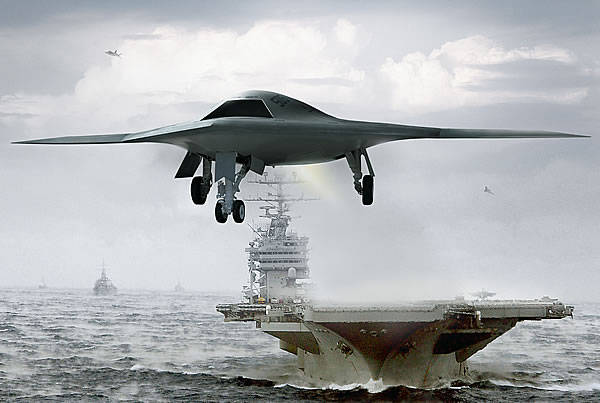
February 4 2011 from the airfield of the Edwards base of the US Air Force in California for the first time the deck-mounted unmanned X-47B unmanned aerial vehicle, created by Northrop Grumman Corporation specifically for the US Navy. The first flight of the UAV was a test and lasted 29 minutes. According to the previously agreed program, the car with uncleared chassis rose to a height of 1,5 kilometer. The flight, during which the operation of the controls, control and automation was checked, passed at a speed of 240,76 km / h, and the maximum speed was 537 km / h. X-47B landed at the point of the runway that corresponds to the “No. 1” cable of the aero-finisher used on the deck of the aircraft carrier.
Flight tests are recognized as successful. In addition, in some American media, he was called “a new chapter in aeronautics” and an “extraordinary step” - just as important as the first take-off from the deck of the ship of the Eugene Ely aircraft in 1910. The creators of the car almost met the 100 summer anniversary of the first landing of Eli's air vehicle on a warship that happened on January 18 of the year 1911. Indeed, this is not a typical event. To him the famous corporation Northrop Grumman has sought more than a decade.
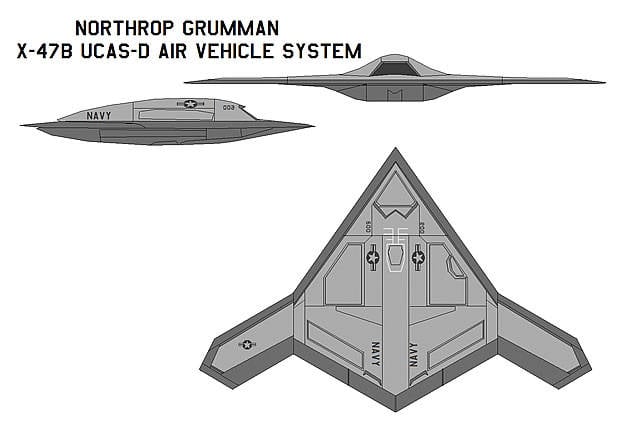
What is the new and, according to American designers, the best UAV? This aircraft is designed according to the "flying wing" scheme, its length is 11,63 meters. Wingspan - 18,9 meters. On drone a Pratt & Whitney F100-220U turbojet engine is installed, which allows speeds up to 540 km / h. The flight range without refueling is 3889 kilometers. This aircraft is provided with a weapons bay, which houses adjustable bombs or reconnaissance equipment. Actually, the X-47B is the strike and reconnaissance complex. It should be noted that the first idea to use combat unmanned aerial vehicles for the needs of the Navy was expressed by the Soviet designer Vasily Nikitin. In the period 1930-1940, he was developing a completely new type of weapon - special-purpose torpedo bombers-gliders according to the "flying wing" scheme in two different versions: unmanned with full automatics (PSN-2) and manned training and sighting (PSN-1). But this revolutionary work remained unfinished due to lack of demand.
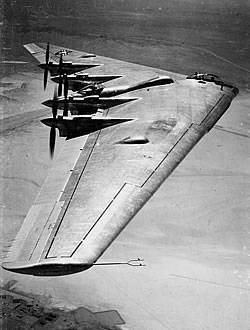 Experienced bomber YB-35
Experienced bomber YB-35The UAV X-47B is the embodiment of the ideas of John Knudsen Northrop, who founded the Northrop Grumman Corporation. In the early 40s of the XNUMXth century, this outstanding designer aviation technicians became interested in the creation of aircraft according to the "flying wing" scheme. Under the direct supervision of “Jack,” as friends and associates called Northrop, a number of experimental machines were built: XP-79, N-1M, N-9M, YB-35, and YB-49. Aircraft of such a scheme have a number of significant advantages: the absence of a fuselage and huge control planes allows to reduce the weight of the airframe and allows to significantly increase the payload, as well as the necessary fuel supply. They have a small effective scattering area, which allows them to remain inconspicuous for radar stations. But Northrop was not able to overcome the drawback of his chosen scheme - the instability associated with the small distance of the control planes from the main center of mass. Aircraft during test flights began to lose the flight line, often fell into a tailspin and crashed. Many years later, after Jack abandoned this topic, new remote control systems appeared that automatically supported the device in a straight flight. A unique monument to the legendary aircraft designer was the creation of a strategic bomber, the “flying wing” Northrop B-2 Spirit. This "invisible" aircraft is in service with the US Air Force.
Eleven years ago, in 2000, the United States Department of Defense announced the start of design development of drone drone. Specialists from Northrop Grumman and Boeing corporations were involved in the program. From the very beginning of development, Northrop Grumman focused on the use of such UAVs from the deck of aircraft carriers, while Boeing focused primarily on the interests of the Air Force. Work on the creation of such UAVs required significant financial resources. The US administration has allocated about $ 4 billion. The first test flight of the Boeing X-45 was performed in May 2002 of the year, and the Northrop Grumman X-47A Pegasus in February 2003 of the year. However, in the end, despite the billions of dollars spent, the program was curtailed. Many pointed out that the main reason - the high cost, the US army as the main customer wanted to get not only a relatively inexpensive, but also a simple attack and reconnaissance drone.
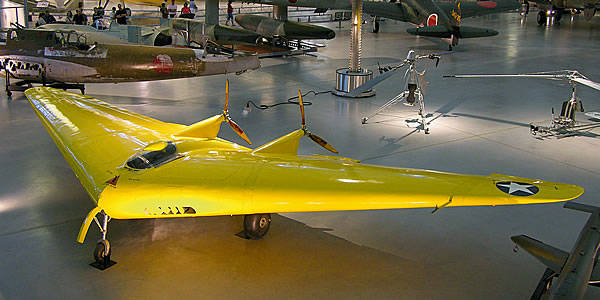
The first "flying wing" of John Northrop - aircraft N-1M
Despite the revolutionism, X-45 and X-47A suffered numerous flaws and did not fully meet the requirements of the customer. For example, Pegasus did not anticipate possible refueling of the device directly during the flight, the U4.3 software integrated into it contained errors in the engine control and control algorithm, the UAV’s technical design did not withstand high overloads, and the delta wing used did not meet maneuverability requirements. But the American fleet still did not abandon the idea of using the shock deck unmanned aerial vehicle. In 2007, Northrop Grumman received a contract directly from the Navy for $ 636 million to develop an improved X-47B UAV. It was planned that for the first time it would take to the air in the 2009 year, and in the 2011 year it would begin its tests directly on the deck. But the elimination of the identified deficiencies took longer than expected.
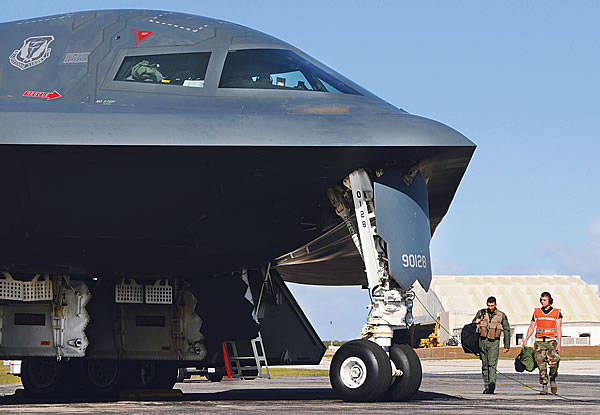
Strategic bomber Northrop B-2 Spirit USAF
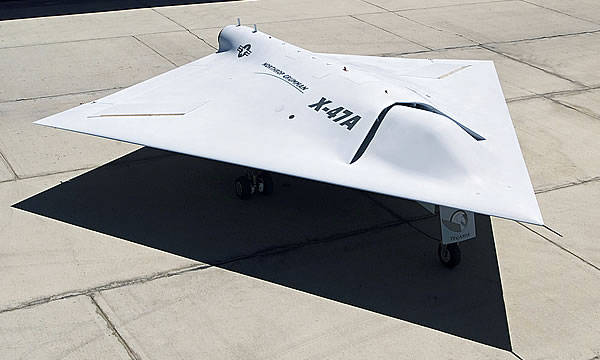
Experimental shock BLA Northrop Grumman X-47A Pegasus
Some nervousness appeared in connection with the connection to the implementation of the General Atomics program. The main question was that, according to American law, the selection of a contractor for the implementation of the program should be carried out only on a competitive basis, given that in this case it is about the fulfillment of defense contracts. 19 March 2010, the US Navy was forced to announce a tender. Requirements, of course, complicated. So, in particular, one of the main requirements was the indication that a UAV with a payload, which includes reconnaissance equipment and weaponmust be in the air for at least 11-14 hours. They should remain unobtrusive, capable of refueling in the air and performing the function of an air refueling agent for other UAVs. Their combat equipment includes ammunition of the JDAM system - a high-precision weapon consisting of the usual GBU-31 and GBU-38 bombs, to which the tail feathers and wings with a guidance system are directly attached. The JDAM system’s ammunition is aimed at the target by an integrated inertial system, combined with the GPS receiver of perfect accuracy, ensuring that they hit the target precisely at a distance of 28 kilometers from the drop point. The magnitude of the circular tolerance is 11 meters. Some JDAM ammunition is also equipped with laser-guided heads in the nose of the bomb.
General Atomics has entered the Sea Avenger UAV project, which is based on the Predator C Avenger turbojet UAV developed for the US Army based on the previously used MQ-9 Reaper (Predator B) turboprop UAV. In the "marine" version, the main change was: the use of folding wings, reinforced landing gear, as well as a fully automatic landing control system.
In October, American publishing house Naval Institute Press published 2010, the book Unmanned Aviation Combat Systems. A new class of carrier-based aviation ”, the author of which is one of the leading experts in naval armament of the United States to date, Norman Friedman. This book is truly original. Most of it is occupied by applications, which, in essence, are a guide to all existing combat-ready unmanned aerial vehicles of the whole world. The main theme of the book is the coverage of the outstanding combat capabilities of the prospective UAV X-47B. Publication of the book, obviously, should be timed to the first flight of this new drone, but due to a number of reasons, it “overtook” the hero of the story.
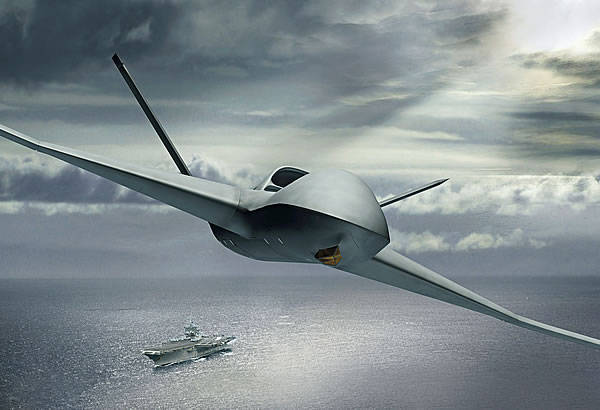
Shock PBLA Sea Avenger company General Atomics
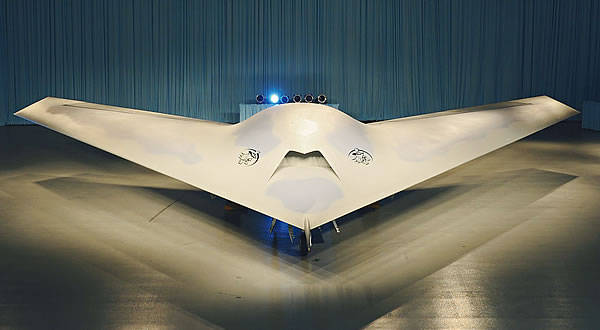
Impact drone Phantom Ray Corporation Boeing
In his book, Norman Friedman does not allow himself to compare the pros and cons of X-47B and Sea Avenger, which, in his opinion, the reader must do. But still, upon careful reading, it is safe to say that the author is impressed with X-47B. In our opinion, and without additional advertising, the chances of the X-47B, which according to the airframe scheme became more similar to the B-2 bomber with a deltoid broken wing than the X-47A Pegasus, outperformed its competitors. According to Scott Winship, vice president of Northrop Grumman's UAV programs for the Navy, this shock drone did not adapt to the requirements of the Navy, and its very initial idea was to land on aircraft carriers and take off using a catapult. It is resistant to the influence of strong winds and is not afraid of a slippery deck. Before the first flight, comprehensive ground tests of more than two hundred electro-hydraulic units were carried out, which are the main components of the UAV design. On the new UAV installed unique software U4.4, which has come to replace the outdated version of U4.3. The company Northrop Grumman has created, and since the beginning of the summer, 2010 of the year began to work out and implement an autonomous high-altitude supplementary refueling system for UAVs, including from similar aircraft. With refueling, the X-47B will be able to continuously perform its combat missions over the course of a 4 day.
After a successful test flight at the Edwards Air Force Base, a flight number 168063 UAV will be forwarded to the Patuxent River Navy base in Maryland, where his tests will continue. At the first stage of testing, the UAV will first rise into the sky only once, and eventually twice a week. According to the preliminary plan of all 50 flights will be executed. In the event that the flights pass without failures, in the 2013 year, deck tests will begin. The results of this final test phase will give the answer - do you need the X-47B US Navy or not. With a positive response to the armament, he will arrive in the 2018 year.
Information